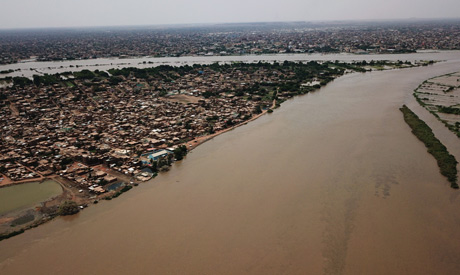
An aerial view shows buildings and roads submerged by floodwaters near the Nile River in South Khartoum, Sudan September 8, 2020. Picture taken September 8,2020 with a drone. REUTERS
Some 100,000 homes damaged, 500,000 persons displaced, 100 dead, 46 injured, 43 schools damaged, more than 2,000 health centres lost at a time when they are crucial, and the grim reminder that there is more to come this month.
Sudan has been ravaged by floods since late July due to heavy seasonal rainfall. The water level of the Nile River rose to about 17.5 metres in August, the highest it has been in close to a century, according to the Sudanese Ministry of Irrigation. With weather forecasts predicting above average rains throughout September, Sudan may reach unprecedented levels of flooding.
Some citizens were reluctant to leave their homes after braving many floods over the years. However, with the water being knee high, or in some cases neck high, all were forced to abandon their houses.
“In previous years, we would leave our house for two months to live with friends, but this year that was impossible, because water had entered their homes too,” said Ahmed, who was caught in the flooding.
Army troops have been deployed to aid citizens in evacuating their homes, building barricades in an attempt to keep the water at bay, and distributing food and supplies to those displaced. Access to clean water has become limited after the flooding destroyed 2,000 sources of clean water. Other utilities, such as electricity, are also experiencing unprecedented outages.
As of last week, the Sudanese government has declared a three-month long state of emergency.
The flooding has, also, been threatening to damage two archaeological sites that house two pyramids that were built around the 7th century BC, which are invaluable historically and the source of much tourism in Sudan. “The situation is currently under control, but if the level of the Nile continues to rise, the measures taken may not be sufficient,” Marc Maillot, head of the French Archaeological Unit in the Sudan Antiquities Service said.
The United Nations has been providing humanitarian aid in the form of food, medical supplies and emergency shelter. On 7 September, Egyptian President Abdel-Fattah Al-Sisi sent two military aircrafts containing provisions and rain-resistant tents. Despite the aid, it may not be enough, with the UN urging the international community to send help as aid stocks have been “depleted rapidly”.
This crisis begs the question of whether or not Sudan can continue to endure these yearly floods, and whether Sudan can withstand a potentially similar, or more serious flood, in the event of the Grand Ethiopian Renaissance Dam malfunctioning.
If anything, this crisis stresses the importance of Sudan, Egypt and Ethiopia cooperating in order to ensure that a crisis of that proportion never happens to Sudan or Egypt in the future.
*A version of this article appears in print in the 10 September, 2020 edition of Al-Ahram Weekly
Short link: